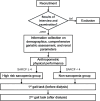Gait abnormalities and longitudinal fall risk in older patients with end-stage kidney disease and sarcopenia
- PMID: 39538169
- PMCID: PMC11559052
- DOI: 10.1186/s12877-024-05506-z
Gait abnormalities and longitudinal fall risk in older patients with end-stage kidney disease and sarcopenia
Abstract
Background: Sarcopenia, gait disturbance, and intradialytic hypotension are among the various factors that contribute to fall risk. This study aimed to investigate the relationship between risk of sarcopenia, hemodialysis (HD) session, and long-term fall risk in older end-stage kidney disease (ESKD) patients by analyzing their spatiotemporal gait characteristics.
Methods: We recruited 22 non-demented patients aged ≥ 65 years who were undergoing maintenance HD. Participants were divided into two groups based on their SARC-F score (< 4 and ≥ 4) to identify those with higher and lower risk of sarcopenia. Demographics, comorbidities, and renal parameters were compared between groups. Inertial measurement unit-based technology equipped with triaxial accelerometry and gyroscope was used to evaluate gait characteristics. The gait task was assessed both before and after dialysis using the Timed-Up and Go (TUG) test and a 10-meter walking test at a regular pace. Essential gait parameters were thoroughly analyzed, including gait speed, stride time, stride length, double-support phase, stability, and symmetry. We investigated the interaction between the dialysis procedure and gait components. Outcome of interest was any occurrence of injurious fall during follow-up period. Logistic regression models were employed to examine the relationship between baseline gait markers and long-term fall risk.
Results: The SARC-F ≥ 4 group showed various gait abnormalities, including longer TUG time, slower gait speed, longer stride time, shorter stride length, and longer double support time compared to counterpart (SARC-F < 4). After HD sessions, the SARC-F ≥ 4 group showed a 2.0-second decrease in TUG task time, an 8.0 cm/s increase in gait speed, an 11.6% lower stride time, and a 2.4% increase in gait symmetry with significant group-time interactions. Shorter stride length and longer double support time were associated with injurious falls during the two-year follow-up.
Conclusion: Our study demonstrated the utility of triaxial accelerometers in extracting gait characteristics in older HD patients. High-risk sarcopenia (SARC-F ≥ 4) was associated with various gait abnormalities, some of which partially improved after HD sessions. These gait abnormalities were predictive of future falls, highlighting their prognostic significance.
Keywords: Fall; Hemodialysis; Older; Sarcopenia; Triaxial accelerometry.
© 2024. The Author(s).
Conflict of interest statement
Figures





Similar articles
-
Limitations of SARC-F as a Screening Tool for Sarcopenia in Patients on Hemodialysis.Nephron. 2022;146(1):32-39. doi: 10.1159/000518810. Epub 2021 Sep 14. Nephron. 2022. PMID: 34535597 Free PMC article.
-
The impact of obesity on static and proactive balance and gait patterns in sarcopenic older adults: an analytical cross-sectional investigation.PeerJ. 2023 Nov 23;11:e16428. doi: 10.7717/peerj.16428. eCollection 2023. PeerJ. 2023. PMID: 38025734 Free PMC article.
-
Gait symmetry in the dual task condition as a predictor of future falls among independent older adults: a 2-year longitudinal study.Aging Clin Exp Res. 2019 Aug;31(8):1057-1067. doi: 10.1007/s40520-019-01210-w. Epub 2019 May 8. Aging Clin Exp Res. 2019. PMID: 31069697
-
Association between dual task-related decrease in walking speed and real versus imagined Timed Up and Go test performance.Aging Clin Exp Res. 2013 Jun;25(3):283-9. doi: 10.1007/s40520-013-0046-5. Epub 2013 May 17. Aging Clin Exp Res. 2013. PMID: 23740587
-
Mapping Associations Between Gait Decline and Fall Risk in Mild Cognitive Impairment.J Am Geriatr Soc. 2020 Mar;68(3):576-584. doi: 10.1111/jgs.16265. Epub 2019 Dec 17. J Am Geriatr Soc. 2020. PMID: 31846071
Cited by
-
Inertial sensor-based gait classification for frailty status in older adults: A cross-sectional study.Comput Struct Biotechnol J. 2025 May 28;28:199-210. doi: 10.1016/j.csbj.2025.05.011. eCollection 2025. Comput Struct Biotechnol J. 2025. PMID: 40585381 Free PMC article.
-
Small vessel disease increases risk of poor outcome through stroke and dementia.Hypertens Res. 2025 Aug;48(8):2234-2242. doi: 10.1038/s41440-025-02242-8. Epub 2025 Jun 4. Hypertens Res. 2025. PMID: 40468038
-
Effect of nutritional intervention combined with resistance exercise on clinical indicators of patients with sarcopenia in maintenance hemodialysis: a systematic review and meta-analysis.Ren Fail. 2025 Dec;47(1):2492365. doi: 10.1080/0886022X.2025.2492365. Epub 2025 Jun 2. Ren Fail. 2025. PMID: 40456518 Free PMC article. Review.
References
-
- Lai TS, Hsu CC, Lin MH, Wu VC, Chen YM. <ArticleTitle Language=“En”>Trends in the incidence and prevalence of end-stage kidney disease requiring dialysis in Taiwan: 2010–2018. J Formos Med Assoc. 2022;121(Suppl 1):S5–11. - PubMed
-
- Annual Data Report: End Stage Renal Disease: Incidence, Prevalence, Patient Characteristics, and, Modalities T. [https://usrds-adr.niddk.nih.gov/2022/end-stage-renal-disease/1-incidence...]
-
- Tinetti ME, Williams CS. Falls, injuries due to falls, and the risk of admission to a nursing home. N Engl J Med. 1997;337(18):1279–84. - PubMed
MeSH terms
Grants and funding
- NCKUH-11102063/National Cheng Kung University Hospital
- NCKUH-11202063/National Cheng Kung University Hospital
- NSTC110-2314-B-006-067/National Science and Technology Council
- NSTC111-2314-B-006-064-MY3/National Science and Technology Council
- NHRI-12A1-CG-CO-04-2225-1/National Health Research Institutes
LinkOut - more resources
Full Text Sources
Medical

